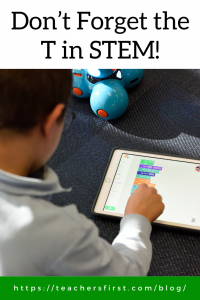Technology – the branch of knowledge that deals with the creation and use of technical means and their interrelation with life, society, and the environment, drawing upon such subjects as industrial arts, engineering, applied science, and pure science.
Dictionary.com
December brings several notable dates related to technology, making it an excellent time to reflect upon how well you incorporate technology instruction into your classroom. Here are just a few noteworthy events from this month in history:
- Eli Whitney was born on December 8, 1765. He is best known for his invention of the cotton gin, but perhaps even more significant was his introduction and promotion of the concept of interchangeable parts. The idea of interchangeable parts led to the ability to mass-produce items instead of each product being created separately without the opportunity to easily replace broken pieces.
- December 20, 1790, marks the date that the first American cotton mill began operation. During this time, textile production was an essential American industry. The introduction of textile mills led to additional technological developments, including power looms that used pulleys and more efficient steam engines.
- On December 17, 1903, Orville Wright piloted the first successful flight of a motor airplane. Among many other inventions that enabled the flight were aircraft controls to make it possible to fly fixed-wing aircraft. The Wright brothers used their knowledge of bicycles to apply concepts of balance to aircraft.
- After years of experiments and developing different theories (over 3,000), Thomas Edison publicly displayed his incandescent lightbulb invention on December 31, 1879. His Menlo Park laboratory in New Jersey produced 1,093 designs and patents.
- The World Health Organization recognized the end of smallpox on December 9, 1979. The knowledge gained when developing the smallpox vaccine lives on today through shared technology that led to vaccines fighting Ebola and other communicable diseases. The fight against smallpox also led to the establishment of health care and immunization programs worldwide.
- Aircraft design technology took a significant step from the Wright brother’s first flight with the first nonstop flight around the world on December 23, 1986. The Rutan Voyager’s manufacturer used years of technological developments in fiberglass, Kevlar, and other materials to develop an aircraft of staying aloft for 216 hours.
- Christmas Eve in 1968 added another significant development in technology when the Apollo 8 team successfully shared a live tv broadcast from the moon. This broadcast capped a series of accomplishments, including the first time humans viewed and photographed the Earth rising over the moon’s surface and extended observations of the lunar surface.

We are all so dependent on technology in everyday living that we don’t always take time to look back and think about how these tools were developed. Sharing prior accomplishments with students provides context for what was, what is, and what could be through innovation and creation.
An excellent resource for helping students develop curiosity and problem-solving mindsets specifically in STEM topics is the STEM Careers Coalition (reviewed here) created by Discovery Education. This website provides digitally immersive activities promoting awareness and curiosity in the many careers and fields requiring technology and innovation.
Some highlights from the STEM Careers Coalition include:
- Student Careers Portal – This area includes 16 career profiles. Each profile consists of an activation PDF that provides a short overview of the career along with a checklist to evaluate student interest. Each career profile also includes a video from a professional in the featured career field and a downloadable career profile guide. The profile guide provides a discussion on job outlooks, estimated salary, training requirements, and a short overview of the job options.
- Classroom Activities – Under the section for educators, this portal shares many teaching activities that guide students toward developing solutions and plans for real-world problems. Each activity guide includes instructions for completing the lesson and correlates to the ISTE Standards for Students (reviewed here).
- Elementary activities include an assortment of topics. Choose a lesson where students develop a plan to reduce school waste or another activity that guides students toward creating video games with characters based in their image to promote computational thinking and diversity. Another lesson guides students toward redesigning a classroom to create space for physical activity to improve fitness. Included in each of the activity guides are suggestions for modifications for students in grades K-2.
- Middle School options include exploring the importance of cybersecurity and creating a model that explains this concept to the general public. Another lesson teaches students to research and design a plan that provides an optimal power solution for a ranger station in Alaska.
- High School activities guide students toward developing options and sustainable energy sources for the aviation industry, problem solving and recommending solutions about internet privacy concerns, and drafting guidelines for textile manufacturers that reduce pollution and waste.
The STEM Career Coalition site is worth a visit to find lessons and activities that blend well with incorporating the T in STEM for all grade levels. If you need additional suggestions, this search on TeachersFirst produced 218 options with the STEM tag.
Making technology relatable to students through activities that include real-world situations and problem solving encourages students to become engaged in their learning and promotes opportunities to extend learning beyond the classroom. Who knows? One of your students might produce the next great invention!
We always enjoy hearing from our readers – we encourage you to share your questions, favorite STEM activities, or advice in the comments below.

